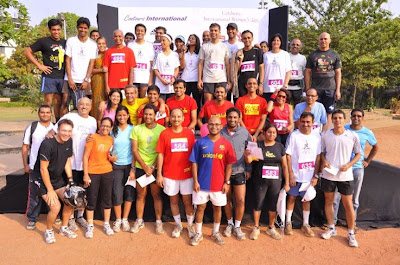One of my key running goals is to continue to improve my full marathon finish time towards my long term objective of qualifying for Boston in a few years. A recent article that I read titled What is your ideal racing weight? written by Matt Fitzgerald (I hope to buy his book 'Racing Weight: How to Get Lean for Peak Performance' soon) for Active.com triggered off some research on the topic. The article says that the optimal weight for a runner also optimises the body fat percentage. To quote from the article:
your (ideal) racing weight is defined as the weight that is associated with the lowest body fat percentage you can attain without overtraining or under-nourishing your body. Because of the strong influence of individual factors, there is no way to accurately predict your lowest healthy body fat percentage, although it is likely to fall in the range of 3 to 9 percent if you're a male under 40, 5 to 12 percent if you're a male over 40, 12 to 17 percent if you're a female under 40, and 15 to 20 percent if you're a female over 40.
Hmm..I guess that's where I need to focus ; however that is going to be challenging. All the distance running over the last 9 years has resulted in a weight reduction of 8-9 pounds but it has now stabilised at 140 pounds(+/- 2 pounds) for the last 4 years or so. I have found it almost impossible to reduce the weight any further - probably beacuse I eat quite a bit and often succumb to temptation wrt to fried foods and desserts(As I have said before what is the point in running so much if one cannot eat and drink as one pleases.
Here are a few more interesting (albeit conflicting) articles I came across on the topic.
Amby Burfoot in an article in Runner's World titled 'What's your ideal weight' says that losing weight almost always helps with running performance. Some excerpts from the article: Lose too much weight, and you become weaker and slower, not stronger and faster. Still, there's no denying that healthy runners will race about two seconds per mile faster for every pound they lose. Weight loss boosts maximal aerobic capacity (VO2 max), an essential contributor to distance-running potential, because the less weight you carry around, the more miles per gallon you get from your oxygen. And because losing a few pounds makes running easier, you should be able to increase your workout distance and speed. So losing weight helps you train harder. The article refers to a 'Flyer Handicap Caclulator' devised by a runner and Physiologist from University of Dayton which "equalises" performances across runners of different weights. As per this calculator, based on my current PB, if I were 25 years old I would complete a FM in about 3 hours 23 minutes!!
Dr. Stillman's height/weight ratio table is discussed in an article on weight and performance in an interesting site called Peak Performance He fixes the non-active man's average weight for height with a simple formula. He allocates 110lbs (56.2kg) for the first five feet (1.524m) in height and 5 1/2lbs (2.296kg) for every inch (0.025m) thereafter. He is harsher with women, giving them 100lbs (45.3kg) for the first five feet and 5lbs (2.268kg) for every inch above this. He then speculates on the ideal weight for athletic performance, as follows:
Sprinters (100-400m): 21/2 per cent lighter than average (6ft/176lbs - 21/2% = 4lbs)Middle-distance runners (800m - 10K): 12 per cent lighter (or 19lbs)
Long-distance runners (10 miles onwards): 15 per cent lighter (or 251/2lbs)
As per this for my height of 5 ft 6 in. the non-active man's average weight is 143 Lbs and as a long-distance runner my weight should be 121 Lbs!. The article also states that as a runner one should aim to be at least 10% lower than the average weight which in my case is about 130 Lbs. That's definitely not going to be possible in this lifetime!!
Both Stillman's height/Weight ratio and also a BMI table are illustrated in the article Weight: The percentage factor. Peak Performance also has a nice article on Body Fat and Running Performance which explains how excess body fat is a disadvantage for endurance runners - the total amount of fat that is needed for energy supply does not exceed about 200g for the average marathon runner!
The last time I measured my body fat % in the SCMM 2010 expo in Janaury it was 18%. So my goal over the next few years is to try and bring it down to say 12% and perhaps get the weight down to 135 lbs. This is a tough ask based on my past experience -I easily tend to put on a few pounds in the off-season when I am not running long distances . To achieve my goal I need to seriously watch my diet . I am seriously thinking of procuring a body fat monitor scale to help in this objective. I welcome comments and enlightenment from other runners and experts on the physiology of running.



